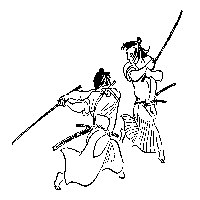

Combat readiness extended beyond
matters of equipment, and a good samurai was so thoroughly indoctrinated
that he/she reacted instinctively to attack. 
Once a samurai had mastered the
techniques of their craft, they never let them drop. They trained daily,
and often travelled about the country in search of ever more exciting teachers.
Their commitment to the art of war was total and unceasing, for according
to their military code, "A samurai should live and die sword in hand...To
be brave and warlike must be his (her) invariable condition".
TESTS FOR NEW SWORDS
Before accepting a new sword,
a samurai had its blade extensively tested--often on a body of a (ulk!)
beheaded criminal. Cuts which have exotic names, varied in difficulty from
one across the hips (1), the hardest, to lopping off a hand (16).
1 ryo kuruma--"pair
of wheels"
2 tai-tai---"very
big"
3 karigane--"wild
goose"
4 chiwari--"splitting
the breast"
5 o-kesa--"priest's
robe"
6 kami-tatewari--"top
vertical split"
7 wakige--"armpit"
8 kurumasaki--"end
of the wheel"
9 suritsuke--"rubbing
in"
10 shimo-tatewar--"bottom
vertical split"
11 san-no-do--"third body
cut"
12 ni-no-do--"second body
cut"
13 ichi-no-do--"first body
cut"
14 ko-kesa--"small priest's
robe"
15 tabigata--"sock region"
16 sodesuri--"cutting the
sleeves"
p.s--. a lot of the samurai materials that you see here can be seen in EARLY JAPAN, a book by Jonathan Norton Leonard & the editors of TIME-LIFE BOOKS
FCOOLINKS:
BUSHIDOLINKS
- For those who seek further knowledge on being Samurai
FWelcome
page
FMain
Page
FSpecial
Feature: